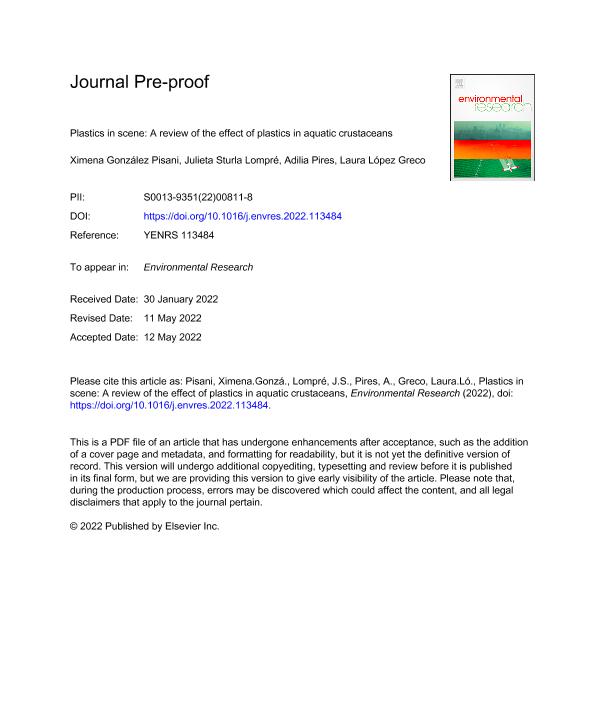Mostrar el registro sencillo del ítem
dc.contributor.author
González Pisani, Pablo Andrés

dc.contributor.author
Sturla Lompre, Julieta

dc.contributor.author
Pires, Adilia
dc.contributor.author
Lopez, Laura Susana

dc.date.available
2023-07-25T12:21:17Z
dc.date.issued
2022-05
dc.identifier.citation
González Pisani, Pablo Andrés; Sturla Lompre, Julieta; Pires, Adilia; Lopez, Laura Susana; Plastics in scene: A review of the effect of plastics in aquatic crustaceans; Elsevier Science; Environmental Research; 212; 5-2022; 1-15
dc.identifier.issn
0013-9351
dc.identifier.uri
http://hdl.handle.net/11336/205200
dc.description.abstract
Plastic pollution in aquatic environments is present in all compartments from surface water to benthic sediment, becoming a topic of emerging concern due to the internalization, retention time, and its effects on aquatic biota. Crustacea with nearly 70,000 species, broad distribution and different roles in the trophic webs is a significant target of the increasing plastic pollution. At least 98 publications in the last 10 years report the impact of plastics in crustaceans, all suggesting that this taxon is at high risk for ecosystem disadvantage by plastic contamination loads. This review compiles the current knowledge on physiological effects (endpoints) by plastic contamination analyzed in crustaceans in the last 10 years, highlighting their use as model species for ecotoxicological tests, sentinels species and bioindicators. Plastic contamination analyzed in this review includes macroplastic, microplastic, and nanoplastic, in a wide variety of types. The studies were focused on 38 marine species with an economic interest in fisheries and aquaculture; 14 freshwater with a higher frequency in standard test species and 4 estuarial and 3 mangrove species with ecological interest. The publications reviewed were divided into studies describing plastic presence in crustaceans without reporting toxic effects and those with analysis of plastic toxicity. Publications describing the plastic presence in the organisms show that the ingestion in individual effects and food-web transfer in ecological effects were the most frequent endpoints. The publications that analyzed plastic toxicity through survival, nutrition-metabolism-assimilation, and reproduction in individual effects, and bioaccumulation in ecological effects were the most frequent endpoints. This review gathers the available information on the use of crustaceans as model species in environmental impact for toxicity screening and hazard assessment. Besides, identifying knowledge gaps will let us propose some future directions in research and the effects on target fisheries species which involves a possible effect on human health.
dc.format
application/pdf
dc.language.iso
eng
dc.publisher
Elsevier Science

dc.rights
info:eu-repo/semantics/openAccess
dc.rights.uri
https://creativecommons.org/licenses/by-nc-sa/2.5/ar/
dc.subject
AQUATIC ENVIRONMENTS
dc.subject
BIOINDICATORS
dc.subject
CRUSTACEA
dc.subject
MODEL SPECIES
dc.subject
PHYSIOLOGICAL ENDPOINTS
dc.subject
PLASTIC POLLUTION
dc.subject.classification
Conservación de la Biodiversidad

dc.subject.classification
Ciencias Biológicas

dc.subject.classification
CIENCIAS NATURALES Y EXACTAS

dc.title
Plastics in scene: A review of the effect of plastics in aquatic crustaceans
dc.type
info:eu-repo/semantics/article
dc.type
info:ar-repo/semantics/artículo
dc.type
info:eu-repo/semantics/publishedVersion
dc.date.updated
2023-07-10T10:36:37Z
dc.identifier.eissn
1096-0953
dc.journal.volume
212
dc.journal.pagination
1-15
dc.journal.pais
Estados Unidos

dc.journal.ciudad
Nueva Jersey
dc.description.fil
Fil: González Pisani, Pablo Andrés. Consejo Nacional de Investigaciones Científicas y Técnicas. Centro Científico Tecnológico Conicet - Centro Nacional Patagónico. Centro para el Estudio de Sistemas Marinos; Argentina. Universidad Nacional de la Patagonia. Facultad de Ciencias Naturales. Sede Puerto Madryn; Argentina
dc.description.fil
Fil: Sturla Lompre, Julieta. Consejo Nacional de Investigaciones Científicas y Técnicas. Centro Científico Tecnológico Conicet - Centro Nacional Patagónico. Centro para el Estudio de Sistemas Marinos; Argentina
dc.description.fil
Fil: Pires, Adilia. University of Aveiro; Portugal
dc.description.fil
Fil: Lopez, Laura Susana. Consejo Nacional de Investigaciones Científicas y Técnicas. Oficina de Coordinación Administrativa Ciudad Universitaria. Instituto de Biodiversidad y Biología Experimental y Aplicada. Universidad de Buenos Aires. Facultad de Ciencias Exactas y Naturales. Instituto de Biodiversidad y Biología Experimental y Aplicada; Argentina
dc.journal.title
Environmental Research

dc.relation.alternativeid
info:eu-repo/semantics/altIdentifier/doi/https://doi.org/10.1016/j.envres.2022.113484
dc.relation.alternativeid
info:eu-repo/semantics/altIdentifier/url/https://www.sciencedirect.com/science/article/pii/S0013935122008118?via%3Dihub
Archivos asociados
